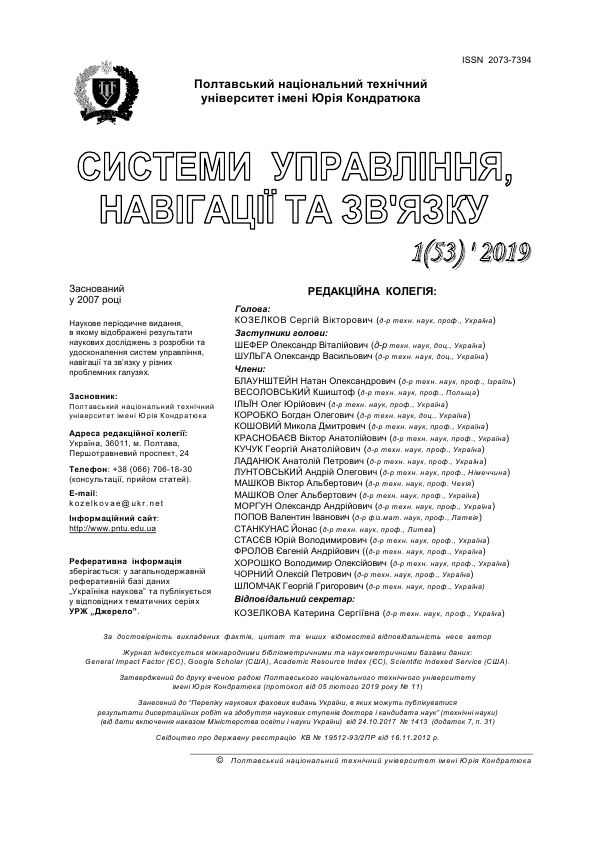ANALYSIS OF TECHNICAL CHARACTERISTICS OF THE RADIOELECTRONIC INTELLIGENCE OF THE RUSSIAN FEDERATION
DOI:
https://doi.org/10.26906/SUNZ.2019.1.142Keywords:
radio communication systems, radio resources, noise immunity, radio electron suppression, radio-electronic intelligence, secrecyAbstract
One of the most important characteristics of radiocommunication systems and facilities that operate in the conditions of radio-electronic suppression is their secrecy, which is the ability of systems and radio communications to withstand the actions of radio-intelligence. Radiotechnical intelligence provides consistent execution of three main tasks: the detection of the fact of the operation of the system (devices) of radio communication (signal detection); determination of the structure of the detected signal and its basic parameters; disclosure of the information contained in the signal. Taking into account the Operations of the Joint Forces in the East of Ukraine caused by the armed aggression of the Russian Federation, an urgent question is raised regarding the analysis of the technical characteristics of the radio-electronic intelligence systems for determining the operation of the radiocommunication equipment of the Armed Forces of Ukraine and the structure of the type of signals used. The authors of this article conducted an analysis of the technical characteristics of the radio-electronic intelligence systems of the Russian Armed Forces to determine the operation of the radiocommunication equipment of the Armed Forces of Ukraine and the structure of the type of signals used. During the research, the authors used the basic provisions of the theory of communication, the theory of electronic warfare, the theory of signals and general scientific methods of analysis and synthesis. According to the results of the research, the following conclusions can be drawn: the frequency range of the electronic intelligence facilities of the Russian Armed Forces is much larger than the frequency range of the radiocommunication facilities of the Armed Forces of Ukraine and technically developed countries of the world; classical methods of increasing impedance and secrecy such as pseudo-random reconstruction of the operating frequency is not able to provide a given level of secrecy. In view of this, the direction of further research should be considered the development of scientific and methodical apparatus for increasing the structural secrecy of radio communications based on the use of time-signal structures.Downloads
References
Shyshatskiy, A.V., Bashkirov, O.M. and Kostina, O.M (2015). “Development of integrated systems and data for Armed Forces”, Arms and military equipment, No 1(5), pp. 35-40. available at : http://journals.uran.ua/index.php/2414- 0651/issue/view/1%285%29%202015 (last accessed november 25, 2018).
Minochkin, A. I. and Kuvshynov, O. V(2014). “Directions of increase of noise immunity of military systems and means of radio communication”. Materials of VІІ-th scientific-technical conferences MITI SYT “Priority areas for the development of telecommunication systems and special purpose networks”. рр. 29-33.
Kuvshynov, O. V(2009). “Adaptive management of devices of protection against military radio systems” Collection of scientific works MIKNY. No. 17. pp.125–130.
Zhuk, O.G., Shyshatskiy, A.V., Zhuk, P.V. and Zhyvotovskyi, R.M (2017). “Methodological substances of management of the radio-resource managing systems of military radio communication”, Information Processing Systems, Vol. 5(151), pp. 16-25. https://doi.org/10.30748/soi.2017.151.02.
Kuvshinov, О.V., Shyshatskiy, A.V., Lyutov, V.V and Zhuk, O.G(2017). “Analysis of ways for increasing the secrecy of broadband radiocommunication systems ” Scientific works of Kharkiv National University of Air Forces, No. 1(50), pp. 24- 28.
Pоpоv, А.О., Tverdokhlibov, V.V(2014). “ General tendencies of development of means of electronic warfare ” Arms and military equipment, No. 4 (4), pp. 4-10.
Serhiienko, V.D., Popov, A.O., Zibin, S.D., Bychkov, A.N., Pidhorodetskyi, M.M (2017). “Analysis of the state of the art of multifunctional electronic warfare means and complexes.” Modern Information Technologies In the sphere of security and defence, No.1(28), pp.135-143.
Zakharchenko, M.V., Gorokhov, S.M., Kochetkov, O.V., Hordiichuk V.V.and Shamshidin, E. B(2017). “Comparison of ensembles of code sets synthesized on the basis of several modules with ensembles realized on the basis of timer signal constructions”, Information processing systems, No. 1(147), pp. 18-21. https://doi.org/10.30748/soi.2017.147.04.
Zakharchenko, M.V, Gorokhov, S.M., Kochetkov, O.V. and Hordiichuk V.V(2016).“Comparison of positional and timer coding”, Collection of scientific works MITI, No 1, pp.59-63.




